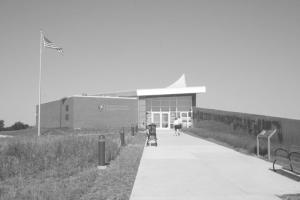Surviving Homesteaders Tell Their Stories At New Heritage Center
 ✖  |
More than 2 million people homesteaded property in more than 30 states. Some of the later homesteaders are still alive and they're telling their stories at a new Homestead Heritage Center in Beatrice, Nebraska. It opened May 20, 2007, the 145th anniversary of President Lincoln signing the Homestead Act.
Anyone interested in U.S. homesteading should visit the center, says Todd Arrington, a historian who works there. Besides beautiful architecture at the two-level, 10,600 sq. ft. center, state-of-the-art displays capture the whole story of homesteading. That includes a real windmill inside the building, a homesteader's 1867 log cabin, displays from Native Americans' perspectives, and the effect of homesteading on tallgrass prairies.
But at the heart of the center are homesteaders' stories in written and taped form, covering the history of the Homestead Act from 1863 to 1986. Arrington interviewed and recorded many of the homesteaders, including the last one in Alaska.
Arrington explains that the center overlooks property originally owned by the country's first homesteader, Daniel Freeman. The Homestead Act went into effect at the same time as the Emancipation Proclamation and the Railway Act during the middle of the Civil War.
The Homestead Act was one of the most significant and enduring events in the westward expansion of the United States. By granting 160 acres of free land to claimants, it allowed nearly any man or woman a chance to live the American dream. More than 270 million acres of land was transferred from federal to private ownership.
Arrington adds that many people don't realize that 60 percent of homesteaders were unsuccessful. They weren't able to overcome harsh conditions to clear the land, build a residence and live on the land for five years. Early homesteaders paid $18 to register and later receive a deed to their land. Fees varied through the years in different states, but the last Alaskan homesteader recalls paying about $50 for his 50-acre claim.
Arrington says he is always amazed by homesteaders' stories of hardship and endurance. "Something that surprised me is that nearly all said they would absolutely, positively do it again, even though it was a hard life," Arrington says.
The center has many stories of early homesteaders and the last homesteaders, but fewer stories from 1920-1960. Part of that is because there were fewer homesteaders due to the Depression and the Taylor Grazing Act in 1934, which withdrew homesteading land from the public domain.
Arrington says the center is interested in hearing homesteader stories. If you were a homesteader or are a descendant of one, send your name, address, telephone number and e-mail to: Friends of Homestead, Homestead National Monument of America, 8523 W. State Highway 4, Beatrice, Nebraska 68310 (ph 402 223-3514).

Click here to download page story appeared in.
Click here to read entire issue
Surviving Homesteaders Tell Their Stories At New Heritage Center AG WORLD Ag World More than 2 million people homesteaded property in more than 30 states Some of the later homesteaders are still alive and they re telling their stories at a new Homestead Heritage Center in Beatrice Nebraska It opened May 20 2007 the 145th anniversary of President Lincoln signing the Homestead Act
Anyone interested in U S homesteading should visit the center says Todd Arrington a historian who works there Besides beautiful architecture at the two-level 10 600 sq ft center state-of-the-art displays capture the whole story of homesteading That includes a real windmill inside the building a homesteader s 1867 log cabin displays from Native Americans perspectives and the effect of homesteading on tallgrass prairies
But at the heart of the center are homesteaders stories in written and taped form covering the history of the Homestead Act from 1863 to 1986 Arrington interviewed and recorded many of the homesteaders including the last one in Alaska
Arrington explains that the center overlooks property originally owned by the country s first homesteader Daniel Freeman The Homestead Act went into effect at the same time as the Emancipation Proclamation and the Railway Act during the middle of the Civil War
The Homestead Act was one of the most significant and enduring events in the westward expansion of the United States By granting 160 acres of free land to claimants it allowed nearly any man or woman a chance to live the American dream More than 270 million acres of land was transferred from federal to private ownership
Arrington adds that many people don t realize that 60 percent of homesteaders were unsuccessful They weren t able to overcome harsh conditions to clear the land build a residence and live on the land for five years Early homesteaders paid $18 to register and later receive a deed to their land Fees varied through the years in different states but the last Alaskan homesteader recalls paying about $50 for his 50-acre claim
Arrington says he is always amazed by homesteaders stories of hardship and endurance Something that surprised me is that nearly all said they would absolutely positively do it again even though it was a hard life Arrington says
The center has many stories of early homesteaders and the last homesteaders but fewer stories from 1920-1960 Part of that is because there were fewer homesteaders due to the Depression and the Taylor Grazing Act in 1934 which withdrew homesteading land from the public domain
Arrington says the center is interested in hearing homesteader stories If you were a homesteader or are a descendant of one send your name address telephone number and e-mail to: Friends of Homestead Homestead National Monument of America 8523 W State Highway 4 Beatrice Nebraska 68310 ph 402 223-3514
To read the rest of this story, download this issue below or click
here to register with your account number.







